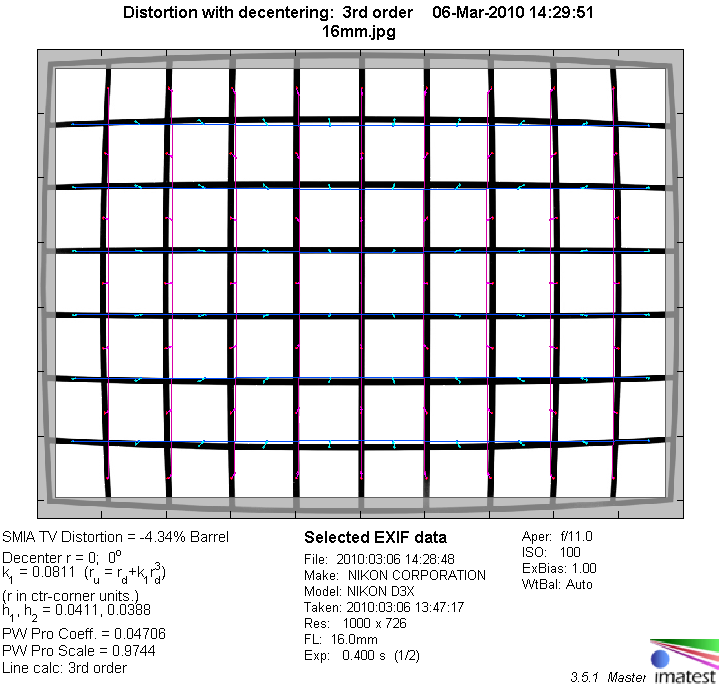|
Page 2 of 3

Distortion
Ultra wide angle lenses usually show a considerable amount of barrel distortion, but it's a little surprising that the AF-S 16-35 VR shows even more of it at the wide end than the AF-S 14-24. A slight amount of barrel distortion is still left at 21 mm while at 28 mm and 35 mm there is some pincushion distortion at close to 1 %.
Especially at the short end, that's fairly hefty, however the good news is that at any focal length distortions are uniform and can easily be corrected by software in post processing (at the expense of resolution and a little field of view, of course).
|
Move the mouse cursor over the focal length text marks below to observe the respective distortion
|
| 16mm |
21mm |
28mm |
35mm |
|

|
The chart above has a real-world size of about 120x80cm.
Vignetting
At the wide end, the lens produces visible vignetting even stopped down, but at all other focal lengths vignetting is well controlled for a wide angle zoom lens. Wide open it can be visible and disturbing, however slightly stopped down the amount of light falloff left is usually not field relevant anymore.
We're performing our vignetting analysis based on
(uncorrected) JPEGs straight from the camera. The JPG engine of the Nikon D3x features a rather flat
gradation curve, thus has a moderate contrast characteristic, resulting in comparatively low vignetting figures - the
corresponding Canon figures are roughly 40% higher due to the more
aggressive default contrast setting.

MTF (resolution)
Let's start with the good news: stopped down to f/5.6, the lens produces excellent resolution figures in the center at any tested focal length. This is also true for wide open aperture at 16 mm, but at any other tested zoom setting the resolution is one mark lower, still very good, though.
At 21 mm and 28 mm, the borders and extreme corners also can reach very good resolution figures if the lens is used stopped down.
At 16 mm and 35 mm, though, the corners and borders fall considerably behind. At 16 mm, the corners wide open only show poor sharpness, but at least considerably stopped down sharpness recovers to a good level, the border sharpness even is very good from f/5.6 onwards. At 35 mm, both borders and corners show good resolution, almost regardless of the chosen aperture. Stopping down does not significantly increase sharpness here.
Please note that the MTF results are not directly comparable across the different systems!
Below is a simplified summary of the formal findings. The chart shows line widths
per picture height (LW/PH) which can be taken as a measure for sharpness.
If you want to know more about the MTF50 figures you may check out the corresponding
Imatest Explanations

Chromatic Aberrations (CAs)
Chromatic aberrations (color shadows at harsh contrast transitions) are in the range of roughly 1 pixel at the image borders throughout most of the focal and aperture range. Only at 16 mm the amount of CAs is a little higher with up to 2 pixels wide open.
However, CAs can easily be corrected in software or by the camera itself (most modern Nikon DSLRs remove CAs themselves if you shoot JPGs).

|